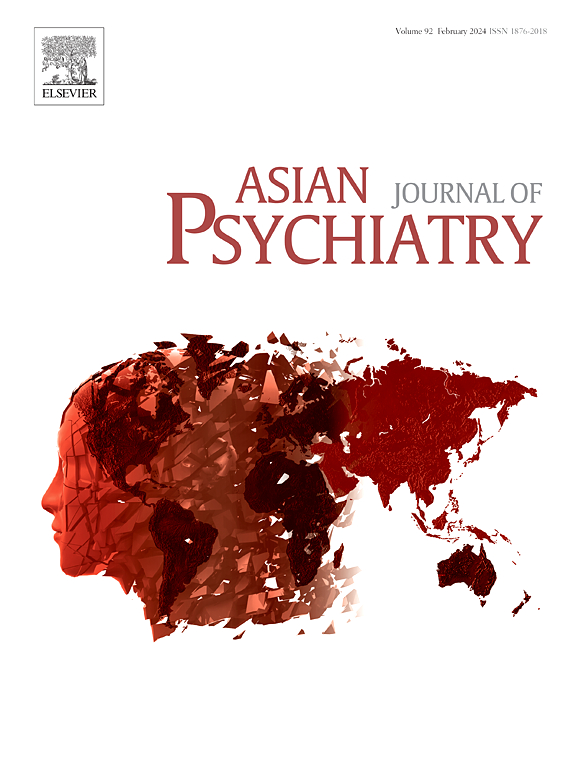Mental health of young adults pursuing higher education in Tier-1 cities of India: A cross-sectional study
IF 3.8
4区 医学
Q1 PSYCHIATRY
引用次数: 0
Abstract
India, with its vast youth population, grapples with significant mental health issues among young adults in higher education, due to factors such as academic pressure, social isolation, stigma, economic uncertainty, screen time, sedentary lifestyles, and pandemic-related stresses. Though the issue has garnered attention, there's a gap in post-pandemic mental health research for Indian students. This study aims to address this by investigating anxiety, depression, and overall mental well-being among students aged 18–29 in higher educational institutions across eight major Indian cities, categorized by gender, zone, city, and institution type. Using a cross-sectional design and multi-stage sampling, we surveyed 1628 students (47.1 % males, 52.9 % females) using the Mental Health Inventory (MHI-38). Female students reported higher distress levels than males. Students from the Western and Southern zones showed higher positivity and well-being. Kolkata students reported low positivity but superior well-being. Hyderabad students reported low depression levels. Central University students reported more depression, while government arts and science college students reported lower life satisfaction. The majority exhibited moderate to high levels of anxiety (69.9 %), depression (59.9 %), loss of behavioral/emotional control (65.1 %), and distress (70.3 %). These statistics underscore the burden of mental health issues faced by this demographic. Despite the prevalence, a minimal number of young adults accessed mental health services, often due to stigma and cultural biases. This study highlights how the post-pandemic context has exacerbated these barriers, revealing significant mental health issues among participants and underscoring the urgent need for targeted interventions in educational institutions amidst rising suicide rates in this demographic.
印度一线城市年轻人接受高等教育的心理健康:一项横断面研究
由于学业压力、社会孤立、耻辱、经济不确定性、屏幕时间、久坐不动的生活方式以及与流行病有关的压力等因素,印度青年人口众多,在高等教育中面临着严重的心理健康问题。尽管这个问题引起了人们的关注,但在大流行后对印度学生的心理健康研究方面存在差距。本研究旨在通过调查印度8个主要城市的18-29岁高等教育机构学生的焦虑、抑郁和整体心理健康状况来解决这一问题,这些学生按性别、地区、城市和机构类型进行了分类。采用横断面设计和多阶段抽样,我们使用心理健康量表(MHI-38)调查了1628名学生(47.1% %男性,52.9% %女性)。女生报告的痛苦程度高于男生。来自西部和南部地区的学生表现出更高的积极性和幸福感。加尔各答学生的积极程度较低,但幸福感较高。海德拉巴学生的抑郁水平较低。中央大学的学生更容易抑郁,而政府文理学院的学生生活满意度较低。大多数人表现出中度至高度的焦虑(69.9% %)、抑郁(59.9 %)、行为/情绪控制丧失(65.1% %)和痛苦(70.3 %)。这些统计数字强调了这一人口所面临的心理健康问题的负担。尽管普遍存在,但很少有年轻人获得精神卫生服务,这往往是由于耻辱和文化偏见。这项研究强调了大流行后的背景如何加剧了这些障碍,揭示了参与者中严重的心理健康问题,并强调了在这一人口中自杀率上升的情况下,迫切需要在教育机构中采取有针对性的干预措施。
本文章由计算机程序翻译,如有差异,请以英文原文为准。
求助全文
约1分钟内获得全文
求助全文
来源期刊

Asian journal of psychiatry
Medicine-Psychiatry and Mental Health
CiteScore
12.70
自引率
5.30%
发文量
297
审稿时长
35 days
期刊介绍:
The Asian Journal of Psychiatry serves as a comprehensive resource for psychiatrists, mental health clinicians, neurologists, physicians, mental health students, and policymakers. Its goal is to facilitate the exchange of research findings and clinical practices between Asia and the global community. The journal focuses on psychiatric research relevant to Asia, covering preclinical, clinical, service system, and policy development topics. It also highlights the socio-cultural diversity of the region in relation to mental health.
 求助内容:
求助内容: 应助结果提醒方式:
应助结果提醒方式:


